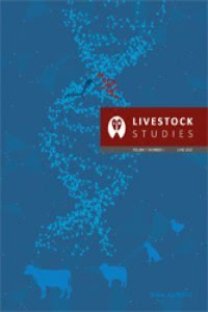Some Morphological and Physiological Characteristics of South Karaman Sheep I- Morphological features, body measurements and live weights
In this study, it was aimed to determine the morphological features, body measurements and weights of South Karaman sheep, which is preferred especially by nomadic breeders in Mersin. The animal material of the study consisted of 100 head South Karaman sheep raised in the nomadic system in Tarsus district of Mersin province. The sheep which remained in the tent in the Bahşiş village that is neighbour of the Tarsus district of Mersin province in winter period, and then they migrated to the Çilnili Lake, which is located within the borders of Çamlıyayla district of Mersin province from the beginning of June to the end of October. In the study, morphological features were determined by observation, and body measurements and weights were determined by measuring. At the end of the study, it was determined that the South Karaman sheep are generally black or blackish ash colour. Males of this breed are usually horned and females are hornless. It was also determined that there is an “S” shaped structure at the end of the fat tail in South Karaman sheep.
Anahtar Kelimeler:
Colour, horn, tail type, live weight, , body measurement
Some Morphological and Physiological Characteristics of South Karaman Sheep I- Morphological features, body measurements and live weights
In this study, it was aimed to determine the morphological features, body measurements and weights of South Karaman sheep, which is preferred especially by nomadic breeders in Mersin. The animal material of the study consisted of 100 head South Karaman sheep raised in the nomadic system in Tarsus district of Mersin province. The sheep which remained in the tent in the Bahşiş village that is neighbour of the Tarsus district of Mersin province in winter period, and then they migrated to the Çilnili Lake, which is located within the borders of Çamlıyayla district of Mersin province from the beginning of June to the end of October. In the study, morphological features were determined by observation, and body measurements and weights were determined by measuring. At the end of the study, it was determined that the South Karaman sheep are generally black or blackish ash colour. Males of this breed are usually horned and females are hornless. It was also determined that there is an “S” shaped structure at the end of the fat tail in South Karaman sheep.
Keywords:
Colour, , horn, tail type, , body measurmenet, , live weight, ,
___
- 1. Akay N, Yılmaz TC, Yılmaz O (2018). Live weight estimation based on linear body measurements of South Karaman sheep breed. Page, 146. I. International Agricultural Science Congress, 09-12 May 2018, Van/Turkey.
- 2. Anonymous (2004). Yerli Hayvan Irk ve Hatlarının Tescili Hakkında Tebliğ, Tebliğ no:2004/39. Resmi Gazete Tarihi: 12.12.2004, sayısı: 25668.
- 3. Anonymous (2013). T.C. Milli Eğitim Bakanlığı, Hayvan Yetiştiriciliği, Küçükbaş Hayvan Yetiştiriciliği. http://docplayer.biz.tr/12421685-Hayvan-yetistiriciligi.html (Erişim tarihi: 26.02.2019)
- 4. Anonymous (2016). Coğrafya Dünyası, http://www.cografya.gen.tr/tr/mersin/ekonomi.html Erişim Tarihi: 19.04.2016
- 5. Anonymous (2018). Hayvansal Üretim.www.tuik.gov.tr (Erişim tarihi; 08.07.2019)
- 6. Aydın M, Keskin M (2018). Muğla ilinde küçükbaş hayvan yetiştiriciliğinin yapısal özellikleri. Mediterranean Agricultural Sciences, 31: 317-323.
- 7. Ayhan V, (2015). Koyun Keçi Irklarımız Tanıtım Klavuzu. Türkiye Damızlık Koyun Keçi Yetiştiricileri Merkez Birliği.. Yayın No: 5 Ankara.
- 8. Bebek DT, Keskin M (2018). Mersin ilinde koyun yetiştiriciliğinin mevcut durumu bazı verim ve yapısal özellikleri. Mustafa Kemal Üniversitesi Ziraat Fakültesi Dergisi, 23 (2): 315-323.
- 9. Boztepe S, Dağ B, Parlat SS, Yıldız AÖ, Aktaş AH (1997).Yağlı Kuyruklu Kimi Yerli Irk Kuzuların Besi Performansı ve Karkas Özellikleri S.Ü. Araştırma Fonu. Proje No: ZF–95/064. Konya
- 10. Demirel M, Aygün T, Altın T, Bingöl M (2000). Hamdani ve Karakaş koyunlarında gebeliğin son döneminde farklı düzeylerde beslemenin koyunlarda canlı ağırlık, kuzularda doğum ağırlığı ve büyüme üzerine etkileri. Turkish Journal of Veterinary and Animal Sciences, 24: 243–249.
- 11. Erol H, Akçadağ Hİ (2009). Halk elinde yetiştirilen Karagül koyun sürülerinde bazı verim özellikleri. Lalahan Hayvancılık Araştırma Enstitüsü Dergisi, 49 (2): 91-104.
- 12. Ertuğrul M, Dellal G, Elmacı C, Akın O, Karaca O, Altın T, Cemal İ (2005). Hayvansal gen kaynaklarının koruma ve kullanımı. Cilt I, sayfa 275-290. Türkiye Ziraat Mühendisliği VI. Teknik Kongresi, Ankara.
- 13. Gül S, Görgülü O, Keskin M, Biçer O, Sarı A (2005). Some prediction equations of live weight from different body measurements in Shami (Damascus) goats. Journal of Animal and Veterinary Advances, 4 (5) : 497-501.
- 14. Hunter DY (2015). Karakul sheep. The Livestock Conservancy News. Spring. 2015, page 6-9. https://karakulsheep.files.wordpress.com/2016/01/karakul-sheep-lc-news-spring-2015.pdf. (Erişim tarihi, 28.02.2019)
- 15. Karagöl E, Keskin M (2018). Problems of nomadic goat breeders and their effects on forest. Mugla Journal of Science and Technology, 4(1): 11-15.
- 16. Koç A, Akman N (2007). Siyah-Alaca tosunların değişik dönemlerdeki vücut ölçüleri ve vücut ölçülerinden canlı ağırlığın tahmini. ADÜ Ziraat Fakültesi Dergisi, 4 (1-2): 21 – 25.
- 17. Özcan L (1989). Küçükbaş Hayvan Yetiştirme-II. Çukurova Üniversitesi Ziraat Fakültesi Yayınları No: 108, Adana.
- 18. Öztürk A (2000). Koyunculuk ve Yapağı. Selçuk Üniversitesi Zootekni Bölümü Ders notları. Konya.
- 19. Sönmez R, Kaymakçı M, Eliçin A, Tuncel E, Wassmuth R, Taşkın T (2009). Türkiye koyun ıslahı çalışmaları. Uludağ Üniversitesi Ziraat Fakültesi Dergisi, 23 (2); 43-65.
- 20. Şahin Ö, Boztepe S, Keskin İ (2018). Anadolu Merinosu erkek kuzularında besi dönemi vücut ölçülerine ait oRtalamalardan canlı ağırlık, canlı ağırlık artışı ve yem tüketiminin tahmini. Selcuk Journal of Agriculture and Food Sciences, 32 (2); 142-145.
- 21. Uğur F (2006). Genel Hayvan Yetiştirme, Ders Notu. Çanakkale Ondekiz Mart Üniversitesi Ziraat Fakültesi Zootekni Bölümü, 97 sayfa.
- 22. Yılmaz O, Cengiz F, Ertuğrul M, Wilson RT (2013). The domestic livestock resources of Turkey: Sheep breeds and cross-breeds and their conservation status. Animal Genetic Resources, 52: 147-163.
- Yayın Aralığı: 2
- Başlangıç: 1959
- Yayıncı: Sezer ÖZ
Sayıdaki Diğer Makaleler
Dilek TÜNEY BEBEK, Mahmut KESKİN
